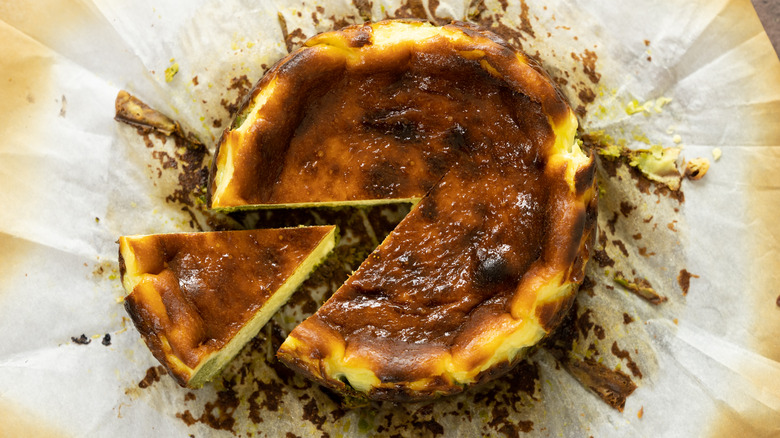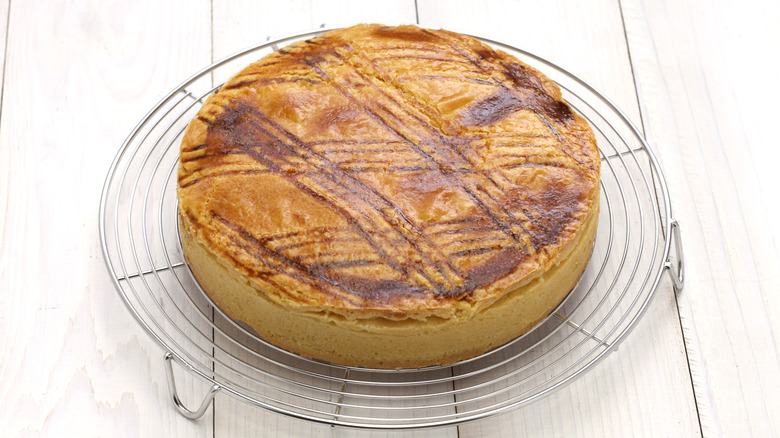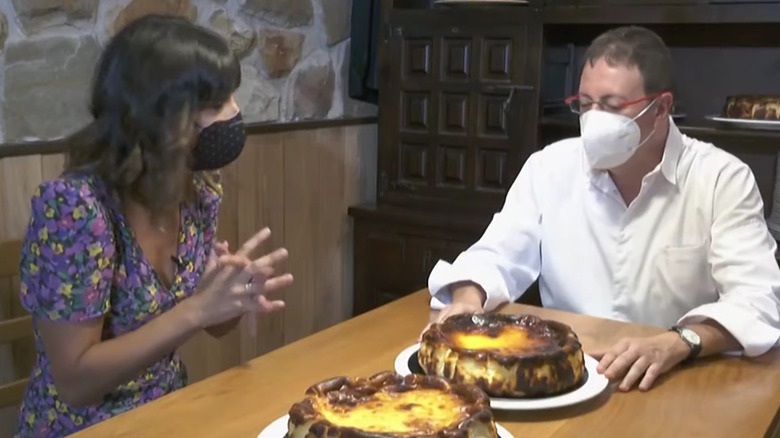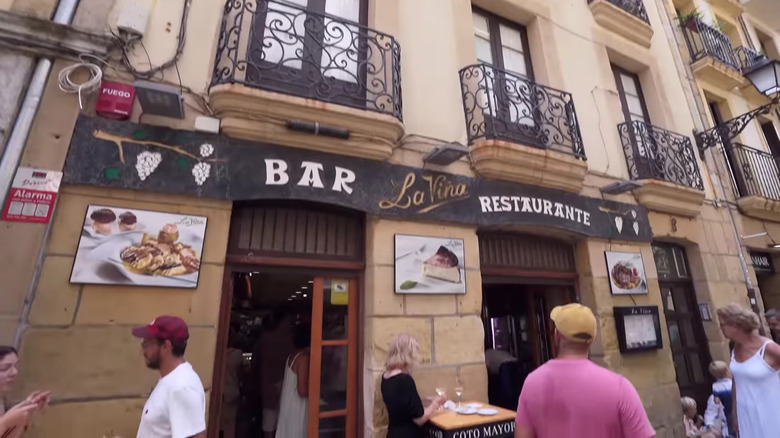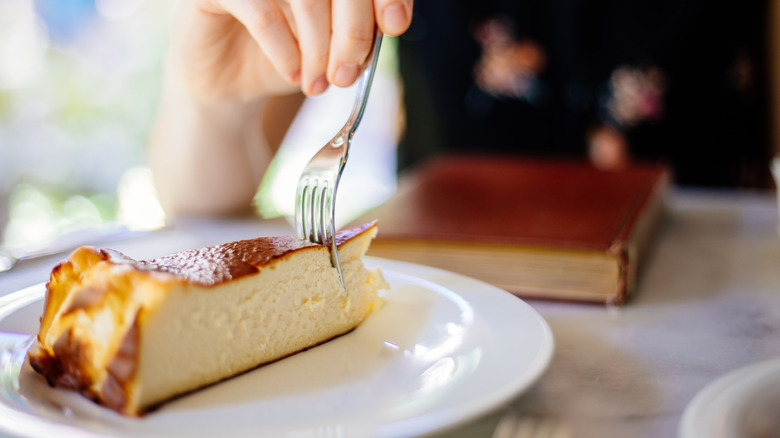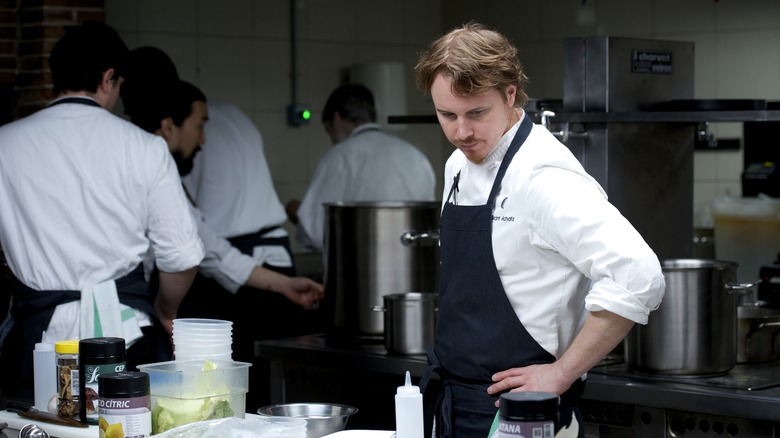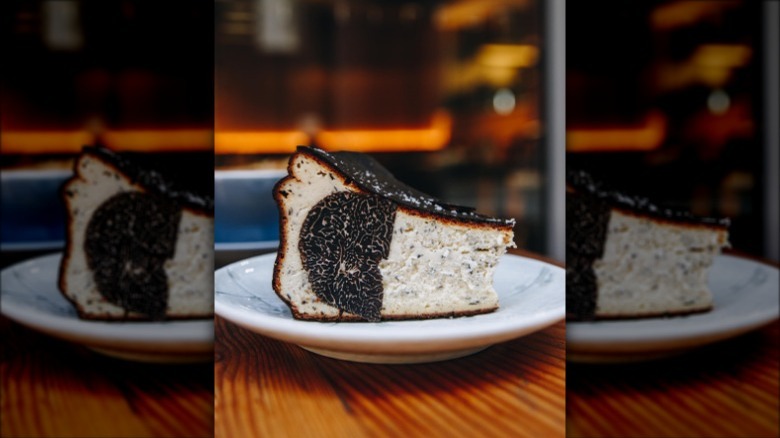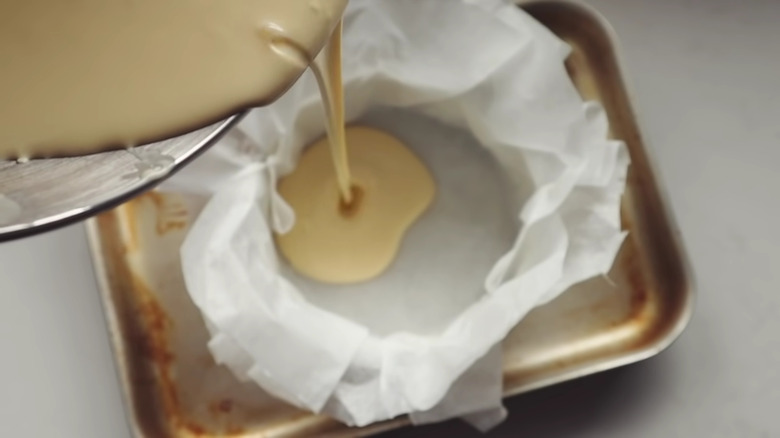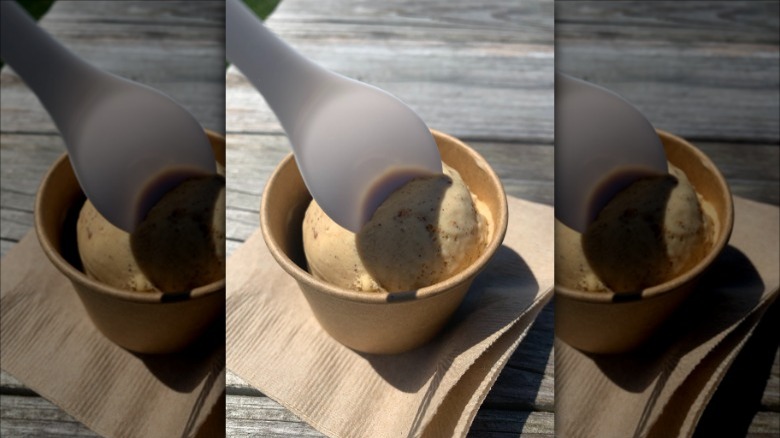The Unexpectedly Recent Origin Of Basque Cheesecake
There are many European desserts that have become globally popular in the past century. These include Italy's now famous tiramisu and Black Forest gâteau from Germany. The latter became popular in the post war years; tiramisu in the 1970s. Spain's addition to this illustrious list, Basque cheesecake, came much later still.
Basque cheesecake is a rustic-looking dessert, devoid of a crust and baked until speckled with burnt spots. The center is still gooey making for an indulgent slice that bears little resemblance to New York City's take on the dessert. Despite its peculiarities — or more accurately, because of them — this dessert has spread from Spain's Basque country to restaurants around the globe. In recent years, Americans have taken a particular liking to it.
Basque cheesecake's history is a study of how recently invented foods can rapidly become a global sensation. Local culture, skill, and adaptation have all contributed to the cake's growing profile. Yet, unlike other foodie fads, Basque cheesecake is no flash in the pan. Instead, it is a brilliant treat that deserves to keep its place alongside Europe's most prestigious desserts.
Basque cheesecake was invented in the food-centric city of Donostia-San Sebastián
Donostia-San Sebastián is a picture perfect city located on Spain's northern coast. Aside from charming architecture and golden beaches, the city also boasts a rich culinary history. It was in Donostia-San Sebastián that pintxos, Northern Spain's famous bite sized dishes, were invented. Txikiteo, the nightly practice of visiting one bar after the other, also began in the city's intricate old town.
Donostia-San Sebastián continues to add to its culinary legacy today. The city's restaurants currently have a combined total of 18 Michelin stars. When coupled with the small population, this number gives Donostia-San Sebastián the third highest number of Michelin stars per capita in the world. Basque cheesecake, however, was not invented in one of the city's Michelin-starred restaurants. Instead, it was created at La Viña, a well-loved restaurant that has been nestled on the fringes of the city's old town since 1959.
The Basque take great pride in their food, it being an extension of their cultural personality. Joxe Mari Aizega, the director of the Basque Culinary Center, explained this to The Gentleman's Journal: "It is not possible to understand Basque people without first understanding our passion for food and cooking. It is a combination of our roots and hedonism, our taste for landscape and traditions." So, it should be no surprise that a small restaurant in this small city has produced a dessert that is now known throughout the world.
The Basque Country has long been known for its desserts
Basque cheesecake is not the only exceptional dessert to have originated in the Basque Country. On the contrary, this area's cuisine is littered with notable sweet treats including gâteau Basque, a cake stuffed with fillings that range from black cherry jam to pastry cream. Cookbook author Dorie Greenspan described gâteau Basque in an interview with NPR: "It's a dry cake, but delicious. I'm always a little afraid to use the word 'dry' with a cake, because it sounds like a fault, but in this cake, it's not at all [...] I mean no disrespect, but it tastes like what a Pop-Tart would taste like, if a Pop-Tart moved up in the world. A grown-up pop tart." Another traditional Basque dessert is goxua, a delightful mix of pastry cream, sponge cake, and cream.
Basque cheesecake follows the precedent set by both gâteau Basque and goxua by being incredibly rich and creamy. This is due to the inclusion of both cream cheese and heavy cream in the cake. Of course, the liberal use of dairy also means traditionally made Basque cheesecake, along with many other Basque desserts, are not suitable for those who are lactose intolerant.
It was invented by a man called Santiago Rivera in the 1990s
Santiago Rivera is the chef-owner of La Viña and the man who invented Basque cheesecake. During the 1990s, Rivera dedicated himself to baking a new cake every day and eventually created Basque cheesecake. After a few alterations, which led to the cake's trademark creamy center, Rivera put it on La Viña's menu under the modest title tarta de queso. It has stayed on the menu ever since.
The dessert gained notoriety in Spain and chefs began creating their own versions. This was encouraged by Rivera who is always keen to give advice — or even his recipe — to those that ask. Gabriella Ranelli, the owner of a Spanish food tour company, highlighted this to Taste: "Santi [Santiago Rivera] has run La Viña for the past 30 years, and he gives his cheesecake recipe away to anyone who will take it! In the early 2000s, I gave the recipe to a woman from Australia who went home and made it, and her friends laughed at her because they thought she was lying about it being burnt because it wasn't yet all over the Internet."
La Viña has become a famed culinary destination
As the birthplace of Basque cheesecake, La Viña has become something of a culinary destination. Chefs and tourists alike wax lyrical about the cheesecake, often obscuring that La Viña offers a wide range of dishes including an extensive array of pintxos.
Thanks to the cheesecake's notoriety, La Viña often has a queue out the door. Chef Miko Aspiras described this when recalling his experience to ANCX: "The store opens at 7 am to 2 pm and then closes for siesta and opens again at 7 pm till late. There was a super long line the entire time so we had to go back. On our third attempt, we were able to get inside the store and finally were able to buy a slice. All the whole cakes were sold already. It was worthy of all the praise. It's made of queso blanco, burnt to perfection with a very creamy center."
Given its popularity, many would forgive Santiago Rivera and La Viña for solely focusing on the cheesecake. Yet, Rivera remains dedicated to improving the standards of all his products, producing a range of food that led to the restaurant being named the best pintxos bar in Donostia-San Sebastián. La Viña continues to receive exceptional reviews thanks to this dedication.
The recipe was incredibly subversive for its time
While a gooey, crustless cheesecake might not have turned many heads in northern Spain for chefs, outside of the country it bordered on revolutionary. Pastry Chef Bea Vo highlighted why this was to Taste: "It breaks all the rules of the porcelain-white, even-textured cheesecake [Americans] know. It's proudly tanned and even burnt in spots, with a rough, pillowy edge and oozy center."
The fact Basque cheesecake throws so many accepted cheesecake-making practices out the window is probably why it took so long for the cake to catch on in America. In fact, it was only 30 years after Rivera invented it that American mainstream media began celebrating it. Early attempts to introduce Basque cheesecake to American customers even failed; Alex Raij of New York's Txikito put it on the menu in 2008 but received next to no response from customers.
Chefs Grant Achatz, Mike Bagale, and David Beran are credited with popularizing it in the United States
Grant Achatz was once a prodigy of Thomas Keller having worked at Keller's famed restaurant, The French Laundry, for four years. After striking out on his own, Achatz founded the immensely successful Chicagoan restaurant Alinea which would go on to earn three Michelin stars. Next, the one Michelin starred sister restaurant, followed a few years later.
Seeking further inspiration for his restaurants, Achatz traveled to Spain in 2013 with Mike Bagale, the sous chef at Alinea, and David Beran who was Next's executive chef. By this time, Santiago Rivera's cheesecake was popular enough for the trio to try it. The chefs loved it so much that they decided to recreate it back in the United States. Beran explained to Taste: "After we got back from Spain, Grant challenged the teams at Alinea and Next to re-create it [the cheesecake]. There were some things we had to rule out immediately. They have a small kitchen. They don't have 12 mixers or a huge staff. We immediately threw out the hydrocolloids. They aren't using a salamander or any of that stuff. It had to be a simple recipe, I just knew it."
Beran went on to create a critically acclaimed version of Basque cheesecake which was served at Next and later his own restaurant, Dialogue. This time the dish was a hit with the public, precipitating the rise of Basque cheesecake in the U.S.
International chefs have since put their own spin on Basque cheesecake
In the culinary world, nothing remains unadulterated for long. Basque cheesecake is the perfect example of this with many chefs putting their own spin on the dessert. One of the main ways they do this without straying too far from the accepted norm is to gently tweak the ingredients list. For example, at Brat, a London restaurant headed by Tomos Parry, Basque cheesecake is made with goat's curd, giving the dish a distinct tang. Nigella Lawson incorporates sour cream for the same reason. Chefs at other establishments have been far more experimental. Cavalier, a coffeeshop in Sydney, sold Basque cheesecake that contained slices of black truffle.
In San Francisco, this tweaking is so prevalent that several businesses solely specializing in varieties of Basque cheesecake have been set up, including Bakusu and Caked up SF. The former sells flavors like black sesame while the latter has become known for everything from ube to Biscoff. Although all these variations abound, La Viña continues to make its tried and tested original as was done over 30 years on. Long may that continue.
There are some common misconceptions about the recipe
Despite Santiago Rivera being generous with his original recipe — a demo of him cooking it can even be bought on DVD – there are many misconceptions about it. Perhaps the most prevalent of these is which type of cream cheese should be used. Again, Gabriella Ranelli gave her opinion on the matter when speaking with Taste: "Everyone says it's made with Philadelphia. And you can make it with Philadelphia, and sometimes Santi makes it with Philadelphia, but actually there is a Spanish cream cheese. I know this because when I moved to San Sebastián there was no Philadelphia [...] most recipes using Philadelphia add salt but the original doesn't contain salt."
Another misconception is that the cake can only be baked at exceedingly hot temperatures. Many recipes do call for oven temperatures of around 500 degrees Fahrenheit, but the cake can easily be made at temperatures around 350 degrees Fahrenheit. If these lower temperatures fail to scorch the top sufficiently the cheesecake can always be placed under a broiler for a few minutes.
Basque cheesecake is now a flavor in its own right
As Basque cheesecake has become a globally popular dessert its flavor profile has transcended that of the traditional dish. Today, the bittersweet flavor of Basque cheesecake appears in a host of other food products. Perhaps the most successful of these is Basque cheesecake-flavored ice cream. Versions of this product have been found far outside of Europe. Australian gelato brand Messina even carried the flavor. The brand's 1-liter tub of gelato was famously topped with a slice of cheesecake.
Flavoring food products to taste like famous dishes is nothing new; it's not that long ago that the public was inundated with dalgona coffee-flavored products. Thankfully, the cheesecake's inventor Santiago Rivera takes the adoption and adaptation of his recipe as a compliment and encourages people to be creative with Basque cheesecake whenever they can. The world's chefs and food product designers haven't needed to be told twice.
